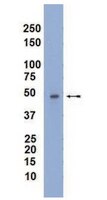MAPKAPK2 and HSP27 are downstream effectors of p38 MAP kinase-mediated matrix metalloproteinase type 2 activation and cell invasion in human prostate cancer.
Xu, L, et al.
Oncogene, 25: 2987-98 (2006)
2006
显示摘要
Although cell invasion is a necessary early step in cancer metastasis, its regulation is not well understood. We have previously shown, in human prostate cancer, that transforming growth factor beta (TGFbeta)-mediated increases in cell invasion are dependent upon activation of the serine/threonine kinase, p38 MAP kinase. In the current study, downstream effectors of p38 MAP kinase were sought by first screening for proteins phosphorylated after TGFbeta treatment, only in the absence of chemical inhibitors of p38 MAP kinase. This led us to investigate mitogen-activated protein kinase-activated protein kinase 2 (MAPKAPK2), a known substrate of p38 MAP kinase, as well as heat-shock protein 27 (HSP27), a known substrate of MAPKAPK2, in both PC3 and PC3-M human prostate cells. After transient transfection, wild-type MAPKAPK2 and HSP27 both increased TGFbeta-mediated matrix metalloproteinase type 2 (MMP-2) activity, as well as cell invasion, which in turn was inhibited by SB203580, an inhibitor of p38 MAP kinase. Conversely, dominant-negative MAPKAPK2 blocked phosphorylation of HSP27, whereas dominant-negative MAPKAPK2 or mutant, non-phosphorylateable, HSP27 each blocked TGFbeta-mediated increases in MMP-2, as well as cell invasion. Similarly, knock down of MAPKAPK2, HSP27 or both together, by siRNA, also blocked TGFbeta-mediated cell invasion. This study demonstrates that both MAPKAPK2 and HSP27 are necessary for TGFbeta-mediated increases in MMP-2 and cell invasion in human prostate cancer. | 16407830
 |
MAPK-activated protein kinase 2 deficiency in microglia inhibits pro-inflammatory mediator release and resultant neurotoxicity. Relevance to neuroinflammation in a transgenic mouse model of Alzheimer disease.
Culbert, Ainsley A, et al.
J. Biol. Chem., 281: 23658-67 (2006)
2006
显示摘要
MAPK-activated protein kinase 2 (MAPKAP K2 or MK2) is one of several kinases directly regulated by p38 MAPK. A role for p38 MAPK in the pathology of Alzheimer disease (AD) has previously been suggested. Here, we provide evidence to suggest that MK2 also plays a role in neuroinflammatory and neurodegenerative pathology of relevance to AD. MK2 activation and expression were increased in lipopolysaccharide (LPS) + interferon gamma-stimulated microglial cells, implicating a role for MK2 in eliciting a pro-inflammatory response. Microglia cultured ex vivo from MK2-deficient (MK2-/-) mice demonstrated significant inhibition in release of tumor necrosis factor alpha, KC (mouse chemokine with highest sequence identity to human GROs and interleukin-8), and macrophage inflammatory protein 1alpha on stimulation with LPS + interferon gamma or amyloid-beta peptide (1-42) compared with MK2+/+ wild-type microglia. Consistent with an inhibition in pro-inflammatory mediator release, cortical neurons co-cultured with LPS + interferon gamma-stimulated or amyloid-beta peptide (1-42)-stimulated MK2-/- microglia were protected from microglial-mediated neuronal cell toxicity. In a transgenic mouse model of AD in which amyloid precursor protein and presenilin-1 harboring familial AD mutations are overexpressed in specific regions of the brain, elevated activation and expression of MK2 correlated with beta-amyloid deposition, microglial activation, and up-regulation of tumor necrosis factor alpha, macrophage inflammatory protein 1alpha, and KC gene expression in the same brain regions. Our data propose a role for MK2 in AD brain pathology, for which neuroinflammation involving cytokines and chemokines and overt neuronal loss have been documented. | 16774924
 |
MAPKAP kinase-2 is a cell cycle checkpoint kinase that regulates the G2/M transition and S phase progression in response to UV irradiation.
Manke, Isaac A, et al.
Mol. Cell, 17: 37-48 (2005)
2005
显示摘要
The cellular response to DNA damage is mediated by evolutionarily conserved Ser/Thr kinases, phosphorylation of Cdc25 protein phosphatases, binding to 14-3-3 proteins, and exit from the cell cycle. To investigate DNA damage responses mediated by the p38/stress-activated protein kinase (SAPK) axis of signaling, the optimal phosphorylation motifs of mammalian p38alpha SAPK and MAPKAP kinase-2 were determined. The optimal substrate motif for MAPKAP kinase-2, but not for p38 SAPK, closely matches the 14-3-3 binding site on Cdc25B/C. We show that MAPKAP kinase-2 is directly responsible for Cdc25B/C phosphorylation and 14-3-3 binding in vitro and in response to UV-induced DNA damage within mammalian cells. Downregulation of MAPKAP kinase-2 eliminates DNA damage-induced G2/M, G1, and intra S phase checkpoints. We propose that MAPKAP kinase-2 is a new member of the DNA damage checkpoint kinase family that functions in parallel with Chk1 and Chk2 to integrate DNA damage signaling responses and cell cycle arrest in mammalian cells. | 15629715
 |


















